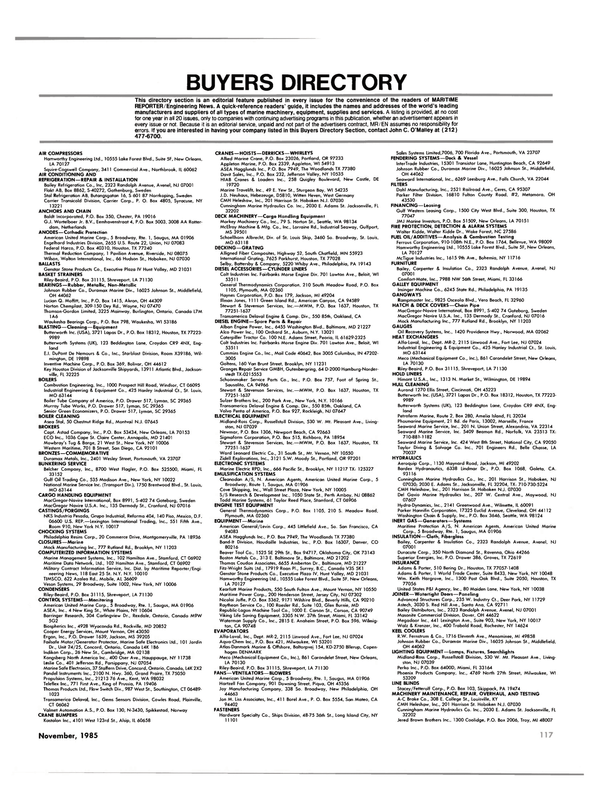
HydroComp Develops Naval Engineering Software Programs
As the competition increases in the marine design field, more and more engineers, naval architects and design firms are turning to microcomputers to develop a marketing edge. Computer-aided calculations are convenient, consistently accurate and fast. The only problem is finding the right software for each job.
HydroComp, Inc., based in Durham, N.J., is one of the few firms in the country offering software programs designed specifically for naval engineering applications. To meet the demand, Hydrocomp now offers NAVCAD—naval architectural computer-aided design software.
HydroComp's programs take standard engineering calculations and package them into a format that is easy, consistent and extremely fast to use. Programs are designed for use on the IBM PC or compatible systems. To aid infrequent users, the company has built automatic checks into NAVCAD and has included an extensive users' manual.
HydroComp recently rewrote three NAVCAD programs—POWER, PROPS and PROPS PLUS—to make them easier to use.
A speed and powering program called POWER calculates vessel resistance and ehp. HydroComp used three well-known ship resistance regressions: the MARIN Regression for conventional displacement vessels, the Great Lakes Bulk Carrier Regression for very full GLBC-type vessels and a Modified Stavitsky Regression for planing hulls. The resistance calculations may be "optimized" by using a modification which applies model test results of a "family-type" hull to empirically fair the coefficient of residuary resistance.
All resistances and appropriate coefficients, and ehps are printed to the screen and/or printer.
Also included in the POWER program is an shp calculation which uses the vessel characteristics and ehp output. Additional propeller data is required. Using appropriate regression equations, propulsive coefficients are determined. Then the program performs an "offdesign point" calculation to determine propeller conditions and shaft power. The propeller evaluation is based on polynominalized data for B-Series, Gawn-Burrill or Kaplan/ Nozzle propellers.
PROPS is a propeller program HydroComp designed to analyze propulsion systems. This program evaluates a range of design or offdesign points, for either free-running or towing conditions for BSeries, Gawn-Burrill or Kaplan/ Nozzle configurations. Various propeller characteristics are needed as well as hull and engine data for offdesign point evaluation. "Complete system values are determined and printed onto the screen or printer, showing thrusts, torques, horsepowers, propeller coefficients and cavitation data," Donald MacPherson, naval architect/marine engineer and vice president of the firm, explained.
Going one step further, PROPS PLUS includes all the calculations in PROPS, plus an optional preliminary calculation to select the diameter, pitch, blade area ratio and reduction gear ratio of an optimal propeller.
"We've redesigned these three programs so that a user can easily step through them without any supporting documentation, Mr. Mac- Pherson said.
For further literature containing full information about these as well as additional NAVCAD programs from HydroComp, Inc., Circle 35 on Reader Service Card
Read HydroComp Develops Naval Engineering Software Programs in Pdf, Flash or Html5 edition of November 1985 Maritime Reporter
Other stories from November 1985 issue
Content
- BPNAP Marine Lubricants Relocates In N e w Jersey page: 5
- Clemlite® System Offers Economy And Safety page: 5
- Fifth Maritime Prepositioning Ship Delivered By Bethlehem-Beaumont page: 6
- Versatile Vickers Awarded Refit Contracts Worth $15 Million From Canadian Navy page: 6
- Todd-Seattle A w a r d ed $ 6 - M i l l i o n N a v y Contract For Work On Support Ship page: 7
- Oceaneering Uses Signals From GPS Satellites To Position Drilling Rig page: 7
- Newman's Offers N ew Brochure On Complete Line Of Ball Valves page: 8
- Royal Navy Purchases Raytheon Bathy System page: 8
- Africa Ocean Lines Getting First N e w Containerships From East German Shipyard page: 9
- Waller Heads N e w Firm Based In San Diego To Provide Contract Management page: 10
- Foss Initiates New Container Feeder Service page: 10
- Fuel Tech Adds F.A. Hughes As Subsidiary, Amalgamating Combustion Technologies page: 10
- Moon Engineering Expands— Moves To Portsmouth, Va. page: 11
- Ingalls Shipbuilding Christens Another Aegis Missile Cruiser page: 12
- Penn Ship Delivers USNS Denebola To The Navy Three Weeks Early page: 16
- Hartley Marine To Operate Walker General Cargo Terminal In Paducah, Ky. page: 16
- Bailey Controls Forms Marine Market Group To Handle Worldwide Sales page: 18
- Metropolitan Offers N ew Grooved Pipe Fittings page: 18
- Jeffboat, Incorporated Delivers Twin-Screw Towboat 'Alois Luhr' page: 20
- Envirovac Receives Contract To Equip Twelve U.S.C.G. Cutters page: 24
- Canadian Engineers To Hold MariTech '86 In Vancouver, June 5-7 page: 24
- Transamerica Delaval's Deltex Repair Facility Offers Free Color Brochure page: 26
- New Manual Details Tank Protection Against 5,000 Products page: 28
- Jorgensen Company New Licensee For Escher Wyss CP Propellers page: 28
- Blue Streak Industries Delivers First Lift Boat With 110-Foot "legs' page: 30
- Pyramid Pump Offers Brochure On Deepwell Barge Pumps page: 32
- Nissen Metal Marker Readable At 2,100° F page: 32
- SNAME Southeast Section Holds General Meeting page: 32
- Alexander Industries Appointed Microphor Representative page: 40
- Hitachi Zosen To Build Giant Submersible Barge page: 41
- Samson Ocean Introduces H i g h - S t r e n g t h Dock Lines page: 41
- MacGregor-Navire Wins Contracts For RO/RO Ramps In U.K. And India page: 42
- Vikubo Offers Free Brochure On Foam-Filled Floating Fenders page: 42
- ' 85 Sales Of Imperial Survival Suits Nears 100,000—Literature Offered page: 43
- BPNAP Offers Free Color Brochure On Products And Services page: 44
- New Chemical Parcel Barging Service Offered In Port Of N e w York page: 45
- 93rd S N A M E Annual Meeting Fourth International Maritime Exposition page: 50
- Raytheon Adds New Frequency To DSF-6000 Fathometer Depth Sounder page: 79
- High-Performance Bearings Reduce Costs By Extending Dredge Life page: 80
- New Edition Of 'Research Manufacturing, Engineering' Now Available From M.A.N. page: 80
- Ogden Completes Sale Of Avondale Industries Common Stock page: 80
- Systonetics Offers Free Brochure On Automated Project Management Systems page: 81
- P.A.D.D. Co. Opens New Drydock To Begin Shipyard Improvements page: 82
- USS Safeguard Commissioned At Peterson Builders' Sturgeon Bay Yard page: 84
- Nippon Kokan To Build Semi-Submersible Rig For Norwegian Firm page: 85
- Transamerica Delaval Offers Broad Range Of Solenoid Valves page: 85
- Moss Point Marine Will Build Two Fireboats Designed By Nickum & Spaulding For Long Beach page: 86
- Marine Machinery Association Sponsors Government-Industry Forum page: 86
- Brown Announces Organizational Changes At Maritime Administration page: 89
- Bretvin Named President And COO Of Stolt-Nielsen page: 89
- Norcontrol Engine-Room Simulator For Singapore Nearing Completion page: 90
- Fiori Named Director Of Special Services At American President page: 90
- W a t e r w a y Operator Survey Launched page: 90
- Newport News/lntelmach Introduce The IM (Intelligent Machine) Series page: 91
- NRL Names Bradley New Superintendent, Acoustics Division page: 91
- N e w Portable Transmitter Provides Emergency Shutdown Control page: 91
- Duramax Introduces Two N e w Styles Of Tow-Knees page: 91
- New Mono-Hull Form Provides Ultra-Stable Drilling Platform page: 92
- MSI Offers 21 MarineSafety Training Courses For 1986 page: 95
- No Lubrication Required For Falk 'Torus' Couplings page: 97
- Eastern Marine Contracted To Build Scallop Trawler page: 98
- TeleSystems' Compact Communications Unit Approved page: 98
- D r e w AMERGIZE® Tested And Chosen For All Ships In Major Fleet page: 99
- Falk Fluid Couplings Provide xSoft-Touch' page: 99
- VIEWNAV® Offshore Platform Monitoring System Installed In North Sea And Off California page: 100
- MSC Awards $22.3-Million Contract To Trailer Marine page: 101
- Hagglund Introduces New Hydraulic Motor page: 101
- KHD And MWM Form New Diesel Engine Group page: 102
- New X-FLO Steam Compressor Fabricated To Withstand Corrosion page: 102
- Renk Gear System Provides Constant-Frequency Power Generation From Main Engine page: 104
- Oerlikon Introduces N e w Line Of Maintenance And Repair Alloys page: 105
- HydroComp Develops Naval Engineering Software Programs page: 109
- Nineteen N e w Members Elected To American Bureau Of Shipping page: 109
- Almerico Joins Moss Point As Vice President page: 109
- Sperry's New Satellite Communicator Granted Unrestricted Type Approval page: 110
- Raytheon Introduces New Commercial 'IMO' Recording Echo Sounder page: 110
- Navigation Sciences Offers Viewnav® Master Mariner Brochure page: 111
- Norcontrol Wins Contracts For Liquid Cargo Control And Monitoring Systems page: 111
- Free Full-Color Brochure On Monitoring System Offered By Siemens AG page: 111
- Aeroquip Offers Bulletin On International Fluid Connector Identification page: 112
- Bethlehem-Sparrows Point To Begin Work On Navy Ocean Survey Ships page: 112
- New Chesterton Cartridge Seal Meets API 610 Specs page: 112
- Japan Radio Introduces Two N e w Products—GSC-80 ODARS And JLR-4000 GPS Navigator page: 113
- Avondale Christens First Of Five Fleet Oilers Building For Navy page: 119
- Alaska Diesel Electric's 'Lugger' Engines Chosen For N e w Tug page: 122
- Uniden® Offers Three New Electronic Aids page: 122
- Polymer Alloy Extends Icebreaker's Propeller Shaft Bearing Life page: 123


